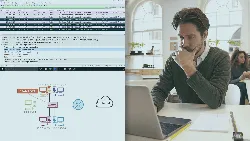
Wireshark for Basic Network Security Analysis 
This project-based course teaches learners how to use Wireshark to capture and analyze network traffic securely. Participants will gain an understanding of encrypted and unencrypted traffic, and learn to differentiate between them. They will also explore protocols such as RADIUS, HTTP, DNS, Telnet, HTTPS, and SSH. Finally, they will learn how to capture and decrypt HTTPS traffic using a pre-master secret key. ▼
ADVERTISEMENT
Course Feature
![]() Cost:
Cost:
Paid
![]() Provider:
Provider:
Coursera
![]() Certificate:
Certificate:
Paid Certification
![]() Language:
Language:
English
![]() Start Date:
Start Date:
17th Jul, 2023
Course Overview
❗The content presented here is sourced directly from Coursera platform. For comprehensive course details, including enrollment information, simply click on the 'Go to class' link on our website.
Updated in [March 06th, 2023]
Learners can learn a variety of topics from this course, including:
1. Network Security Analysis: Learn how to use Wireshark to capture and analyze network traffic, differentiate between encrypted and unencrypted traffic, and dig deeply into unencrypted protocols such as RADIUS, HTTP, DNS, and Telnet.
2. Secure and Encrypted Protocols: Generate, capture, and look into secure and encrypted protocols such as HTTPS and SSH. Learn how to capture HTTPS traffic and decrypt it using a pre-master secret key.
3. Network Traffic Generation: Generate the traffic of each protocol and capture it yourself to gain a better understanding of how it works.
4. Regional Availability: This project works best for learners based in the North America region, but the same experience is being worked on for other regions.
Pros & Cons

Content was ok but very basic.

Gave a good review of Wireshark capabilities.

Enlightened to how insecure some network communications are.

Little explanation on why certain settings are done.

Issues in 3 of the exercises.

Nonrefundable.
Course Provider

Provider Coursera's Stats at AZClass
Discussion and Reviews
0.0 (Based on 0 reviews)
Explore Similar Online Courses

Create an Infographic in Canva

Avoid Overfitting Using Regularization in TensorFlow

Python for Informatics: Exploring Information

Social Network Analysis

Introduction to Systematic Review and Meta-Analysis

The Analytics Edge

DCO042 - Python For Informatics

Causal Diagrams: Draw Your Assumptions Before Your Conclusions

Whole genome sequencing of bacterial genomes - tools and applications

Mastering TCP Analysis with Wireshark

Wireshark Traffic Analysis: Customizing the Interface ARP ICMP and DNS


Start your review of Wireshark for Basic Network Security Analysis